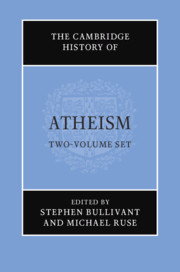Book contents
- The Cambridge History of Atheism
- The Cambridge History of Atheism
- Copyright page
- Dedication
- Contents
- Acknowledgments
- Contributors
- Introduction
- Part I Preliminaries
- Part II Atheisms in History
- Part III Reformation, Renaissance, Enlightenment
- Part IV Classical Modernity: Philosophical and Scientific Currents
- Part V Classical Modernity: Social and Political Currents
- Part VI Twentieth and Twenty-First Centuries: Intellectual and Artistic Currents
- 32 Analytic Philosophy
- 33 Naturalism
- 34 Existentialism
- 35 Atheism and Postmodern Philosophies
- 36 Ayn Rand and Objectivism
- 37 Darwinism
- 38 Literature
- 39 Music
- 40 Visual Arts
- 41 Film and Television
- Part VII Lived Atheism in the Twentieth- and Twenty-First Centuries: Case-Studies
- Part VIII Emerging Atheisms in the Twenty-First Century
- Part IX Conclusion
- Index
- References
41 - Film and Television
from Part VI - Twentieth and Twenty-First Centuries: Intellectual and Artistic Currents
Published online by Cambridge University Press: 25 September 2021
- The Cambridge History of Atheism
- The Cambridge History of Atheism
- Copyright page
- Dedication
- Contents
- Acknowledgments
- Contributors
- Introduction
- Part I Preliminaries
- Part II Atheisms in History
- Part III Reformation, Renaissance, Enlightenment
- Part IV Classical Modernity: Philosophical and Scientific Currents
- Part V Classical Modernity: Social and Political Currents
- Part VI Twentieth and Twenty-First Centuries: Intellectual and Artistic Currents
- 32 Analytic Philosophy
- 33 Naturalism
- 34 Existentialism
- 35 Atheism and Postmodern Philosophies
- 36 Ayn Rand and Objectivism
- 37 Darwinism
- 38 Literature
- 39 Music
- 40 Visual Arts
- 41 Film and Television
- Part VII Lived Atheism in the Twentieth- and Twenty-First Centuries: Case-Studies
- Part VIII Emerging Atheisms in the Twenty-First Century
- Part IX Conclusion
- Index
- References
Summary
To speak of the relationship between atheism, on one hand, and film and television, on the other, is a thorny endeavor. There are, after all, a plethora of variables to consider. A given filmmaker might hold atheistic beliefs but make movies with obvious religious import – for example, the great Italian director Pier Paolo Pasolini, whose 1964 film The Gospel According to Matthew [Il vangelo secondo Matteo] was dedicated to Pope John XXIII. Conversely, another filmmaker might be a well-known theist but release movies that highlight atheistic characters and themes – to wit, Martin Scorsese, who has explored godlessness in films such as Mean Streets (1973), The Departed (2006), and even in ostensibly religious works such as Silence (2016).
- Type
- Chapter
- Information
- The Cambridge History of Atheism , pp. 740 - 760Publisher: Cambridge University PressPrint publication year: 2021
References
- 1
- Cited by



